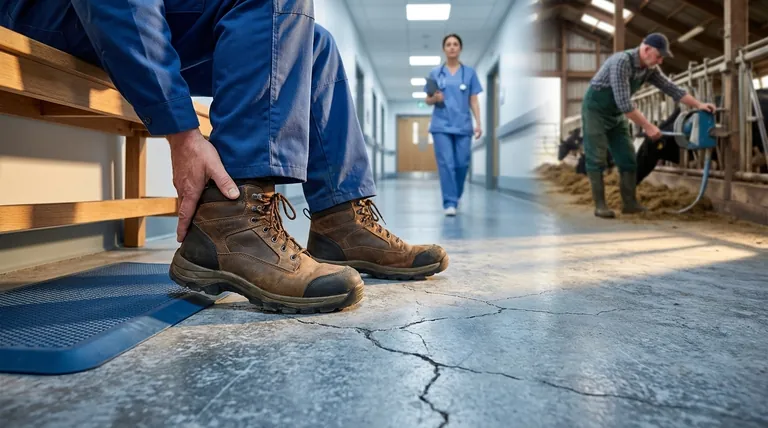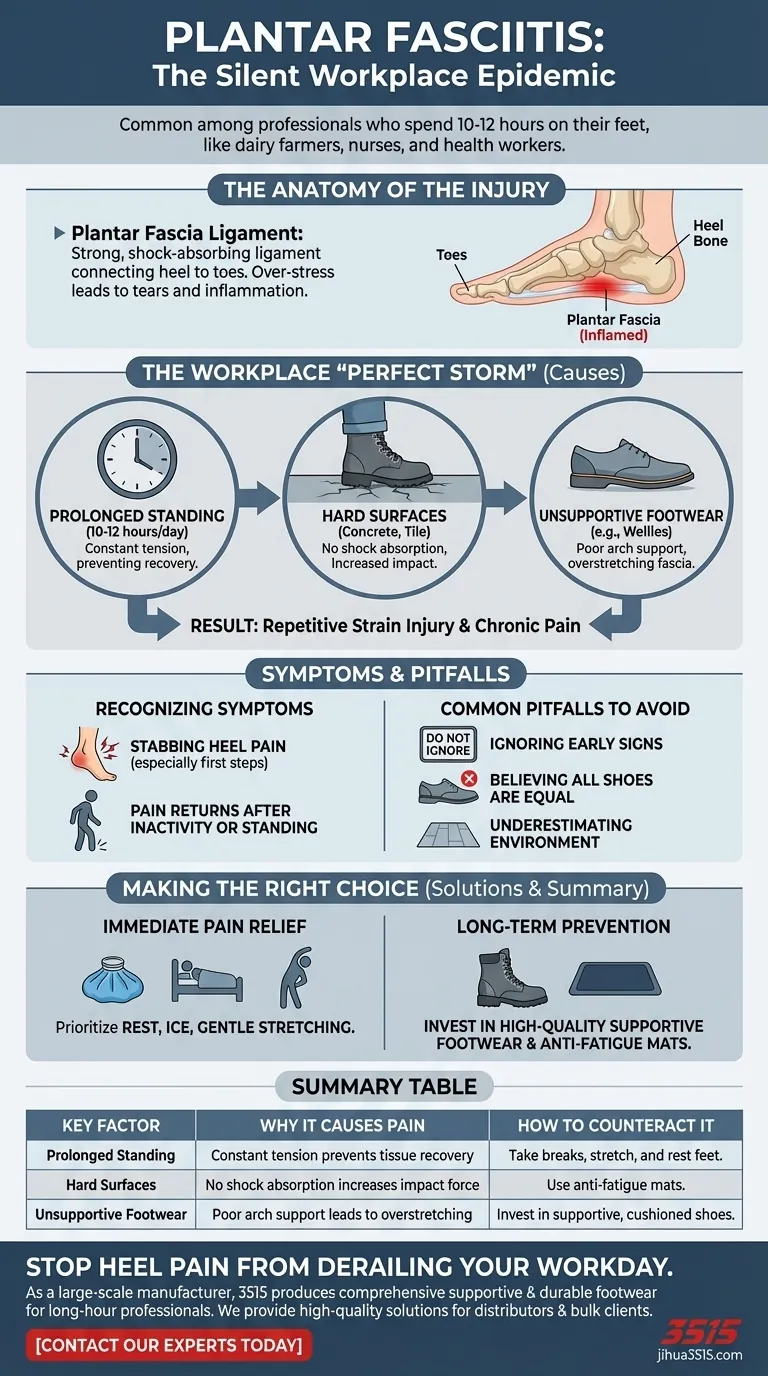At its core, plantar fasciitis is an inflammation of the thick band of tissue connecting your heel bone to your toes, causing a distinct, sharp pain in the heel. This condition is particularly common among professionals like dairy farmers, nurses, and other health workers who spend 10-12 hours a day on their feet. The primary cause is the relentless strain from standing on hard surfaces, often made worse by unsupportive footwear.
The key insight is that plantar fasciitis is not a random ailment, but a repetitive strain injury. It's the predictable outcome of subjecting your feet to a combination of three factors: prolonged standing, hard surfaces, and inadequate footwear.

A Closer Look at Plantar Fasciitis
The Anatomy of the Injury
The plantar fascia is a strong, bowstring-like ligament that supports the arch of your foot and acts as a shock absorber. When this tissue is over-stressed and overworked, tiny tears can occur, leading to inflammation and irritation. This inflammation is what causes the characteristic pain of plantar fasciitis.
Recognizing the Symptoms
The most common symptom is a stabbing pain in the bottom of your heel. This pain is often at its worst with the first few steps after waking up or after long periods of inactivity. It may decrease during the day but can return after long periods of standing or when you stand up after sitting.
The Workplace Factors Driving the Pain
For professions that require being on your feet all day, the environment creates a perfect storm for developing this condition.
The Strain of Prolonged Standing
Standing for 10-12 hours a day places constant tension and stress on the plantar fascia. Without adequate breaks or opportunities to rest and stretch, the tissue never gets a chance to recover, leading to chronic irritation.
The Unforgiving Nature of Hard Surfaces
Concrete, tile, and other hard flooring offer virtually no shock absorption. Every step sends a jarring force up through your foot, which the plantar fascia must absorb. Over time, this repeated impact overwhelms the tissue's ability to cope.
The Critical Failure of Unsupportive Footwear
Footwear is the final, and often most critical, factor. Shoes with poor arch support and minimal cushioning, like the wellies often worn by farm workers, fail to protect the foot. They allow the arch to collapse and the plantar fascia to overstretch, directly contributing to the injury.
Common Pitfalls to Avoid
Understanding the causes allows you to see the common mistakes that either trigger or worsen the condition.
Ignoring Early Warning Signs
Many people push through the initial heel pain, assuming it will go away on its own. Ignoring this early inflammation allows the damage to accumulate, making recovery longer and more difficult.
Believing All Shoes Are Equal
Choosing footwear based on convenience or uniform requirements without considering arch support and cushioning is a major pitfall. The right shoe is a tool for your job, not just an accessory.
Underestimating the Environment
Failing to modify your direct work environment is a missed opportunity. Standing directly on concrete for an entire shift puts you at a significant disadvantage, even with good shoes.
Making the Right Choice for Your Health
To address plantar fasciitis, you must systematically counteract the factors causing it.
- If your primary focus is immediate pain relief: Prioritize rest, ice on the heel, and gentle stretching to reduce inflammation and ease tension in the fascia.
- If your primary focus is long-term prevention: Invest in high-quality, supportive footwear with proper arch support and consider using anti-fatigue mats in your primary standing area.
By understanding the root causes, you can take proactive steps to protect your feet and ensure your career doesn't come at the cost of your mobility.
Summary Table:
| Key Factor | Why It Causes Pain | How to Counteract It |
|---|---|---|
| Prolonged Standing | Constant tension prevents tissue recovery. | Take breaks, stretch, and rest feet. |
| Hard Surfaces | No shock absorption increases impact force. | Use anti-fatigue mats in work areas. |
| Unsupportive Footwear | Poor arch support leads to overstretching. | Invest in shoes with proper arch support and cushioning. |
Stop heel pain from derailing your workday. As a large-scale manufacturer, 3515 produces a comprehensive range of supportive and durable footwear specifically designed for professionals who spend long hours on their feet. We provide high-quality shoes and boots for distributors, brand owners, and bulk clients, ensuring your team has the proper arch support and cushioning needed to prevent plantar fasciitis. Contact our experts today to find the right footwear solution for your business needs.
Visual Guide

Related Products
- Safety Footwear Wholesale Manufacturer for Custom OEM/ODM Production
- Custom Wholesale Leather Safety Boots Direct Factory Manufacturing
- Durable Rubber-Soled Utility Shoes for Wholesale & Custom Brand Manufacturing
- Customizable Anti-Smash Safety Boots for Wholesale & Private Label Manufacturing
- Premium Sport Style Safety Boots for Bulk Orders
People Also Ask
- How do safety shoes contribute to cost savings for companies? A Strategic Investment in Risk and Cost Management
- Is safety-toe as good as steel toe? Choose the Right Protection for Your Job
- Do snake bite boots work? Your Ultimate Guide to Effective Snake Bite Protection
- What do heavy duty boots do? Protect Your Feet in Demanding Work Environments
- Is it normal to wear shoes in the house? A Guide to Hygiene, Comfort & Culture



















